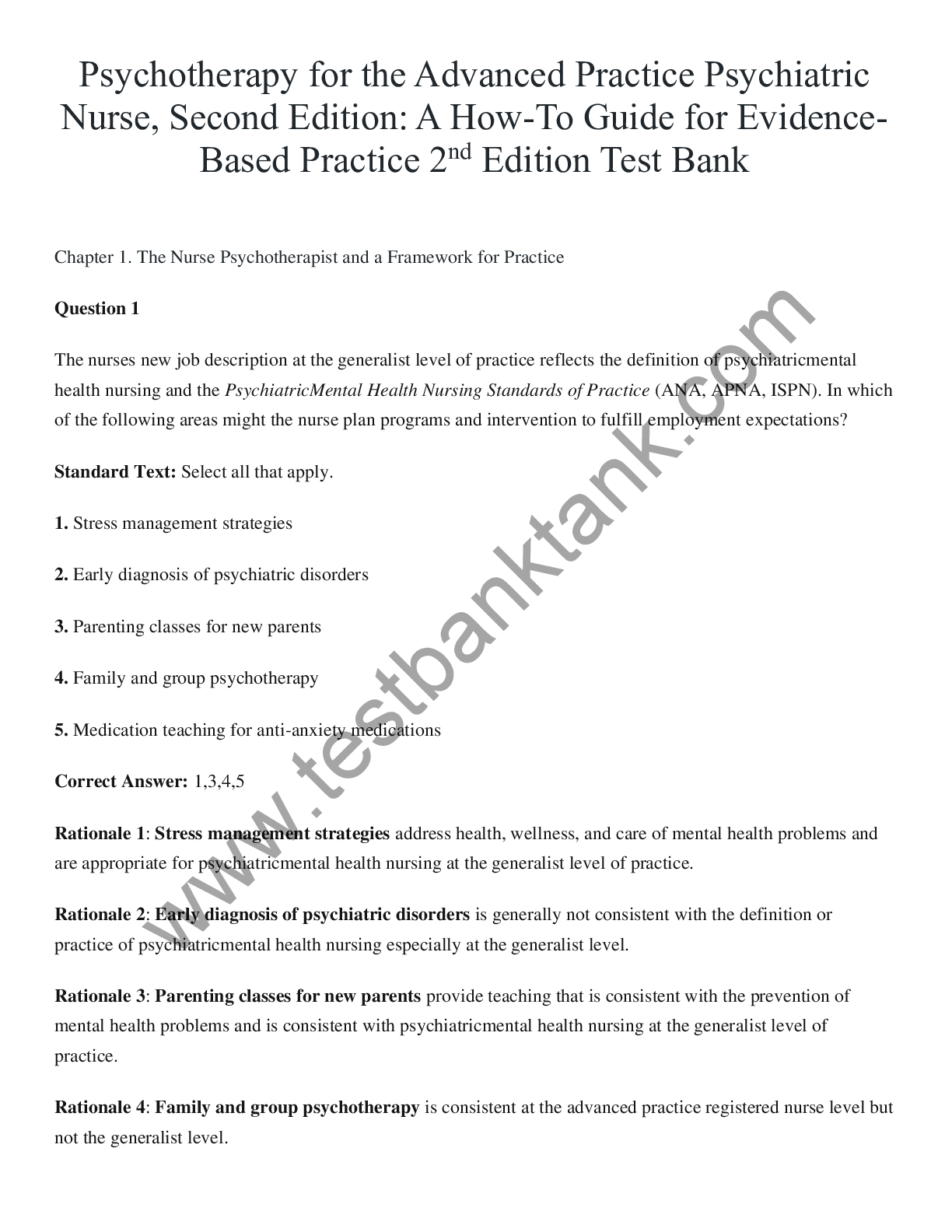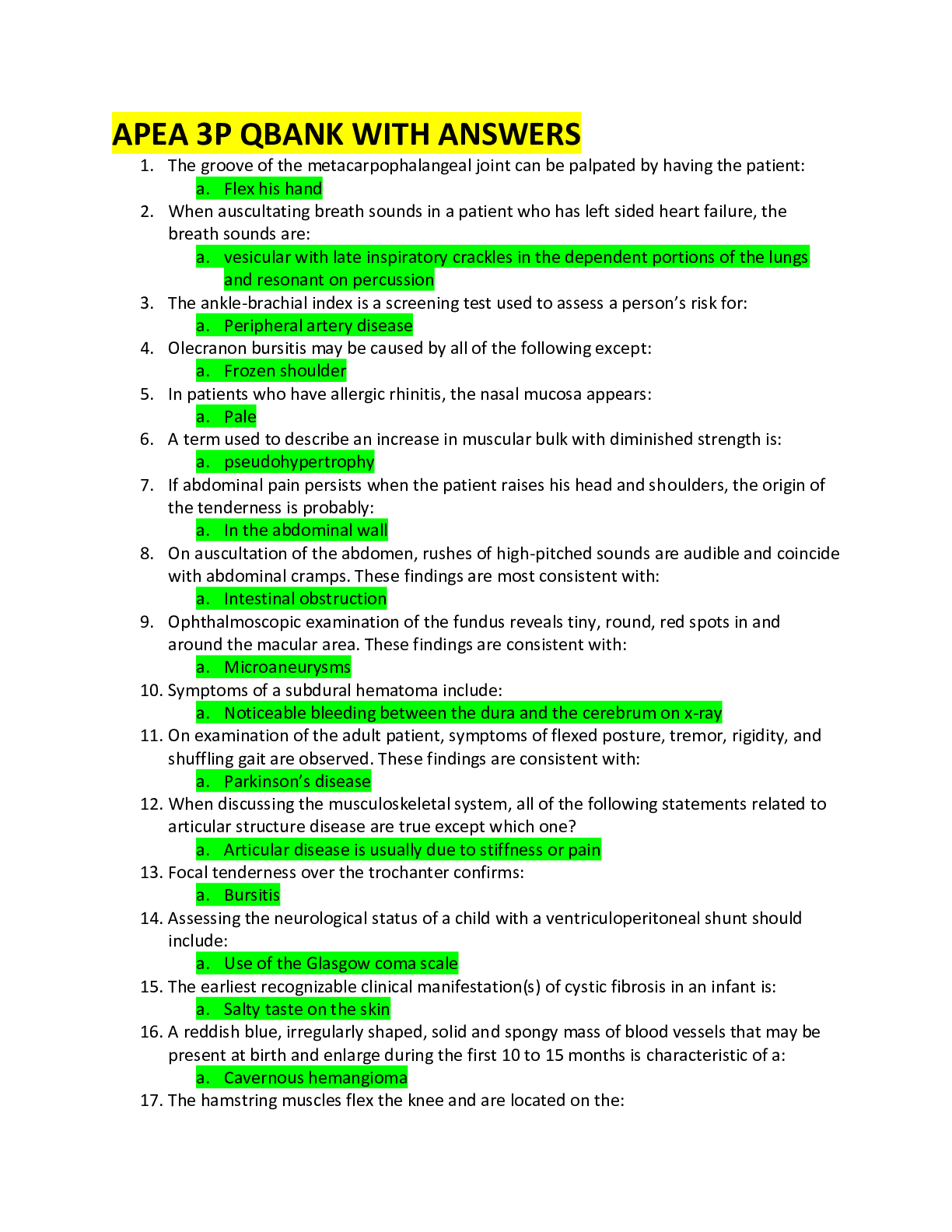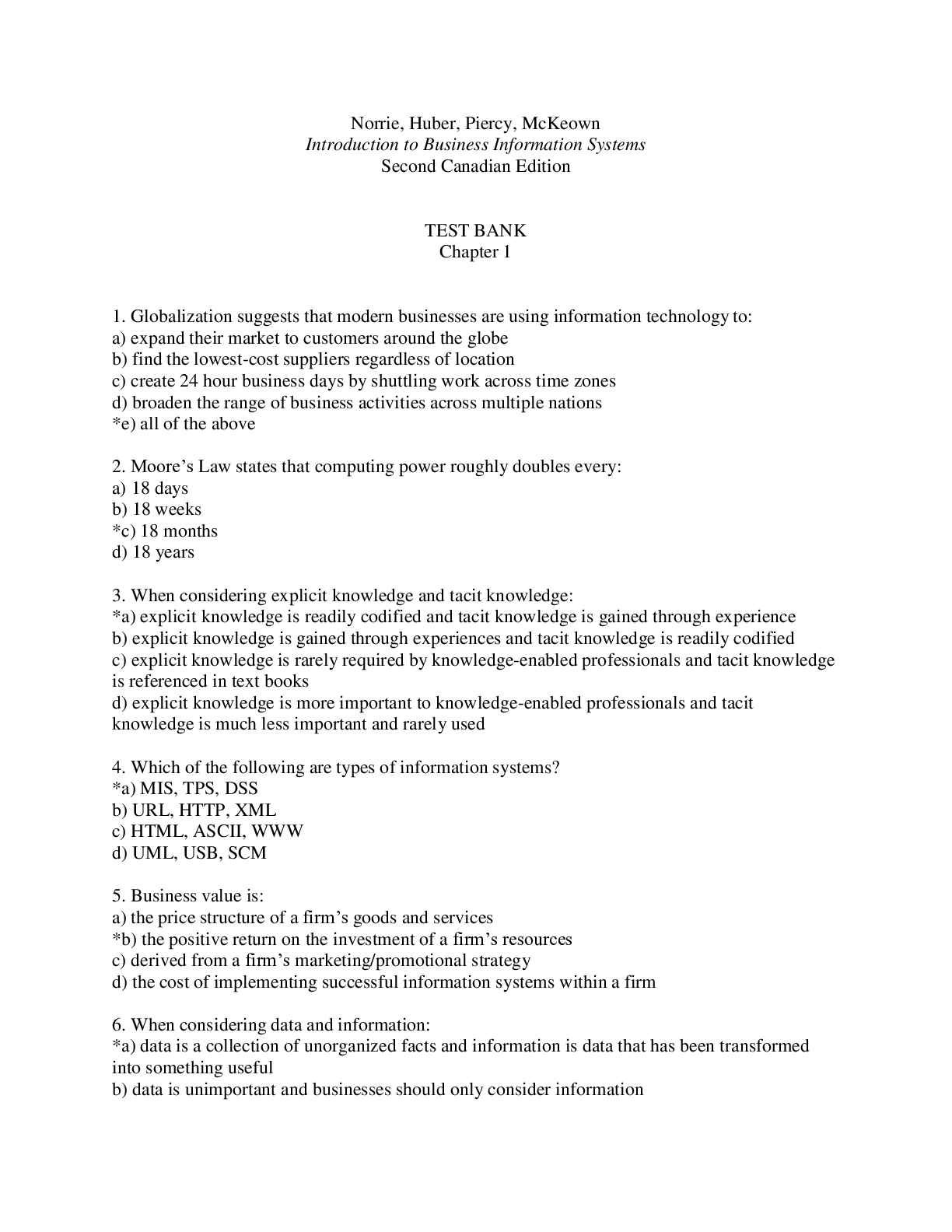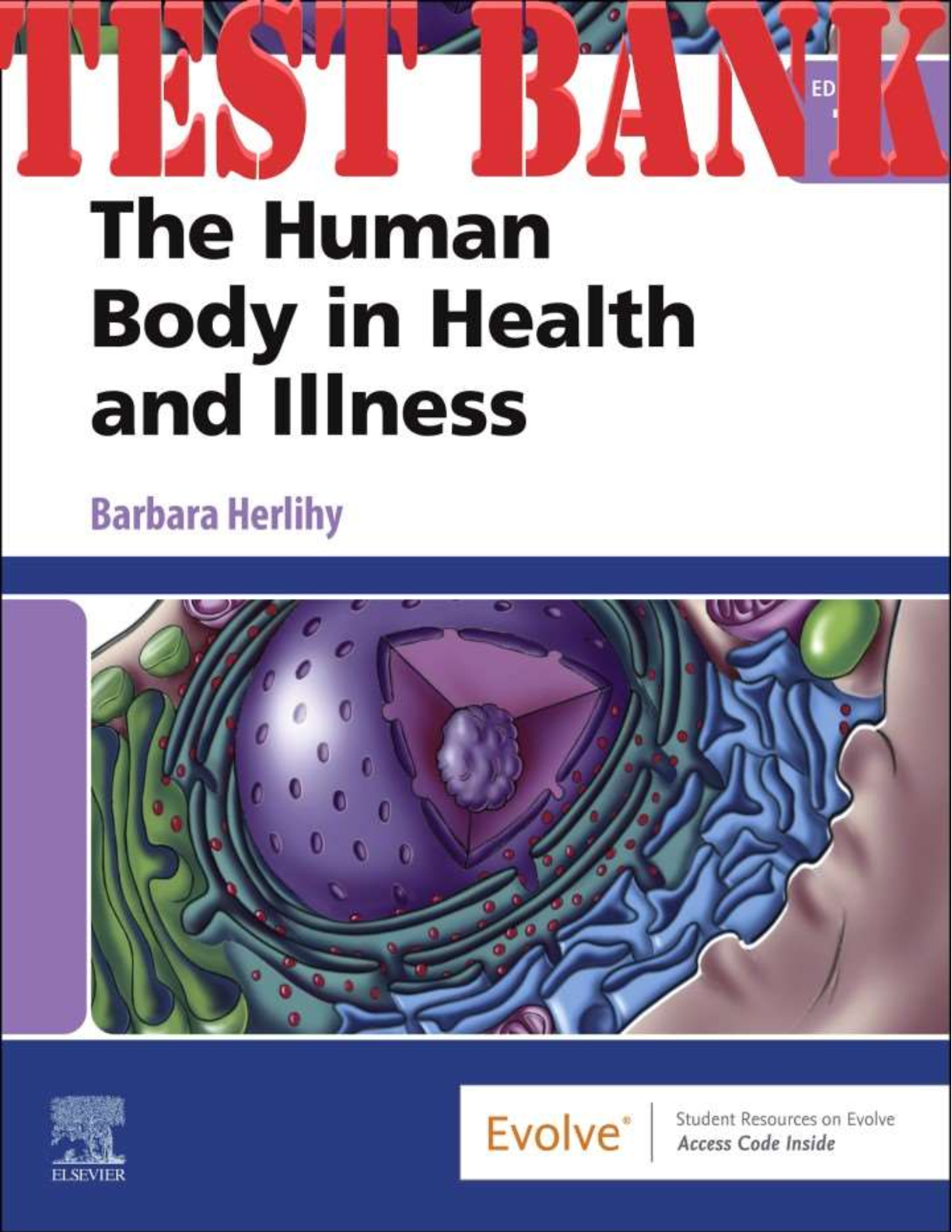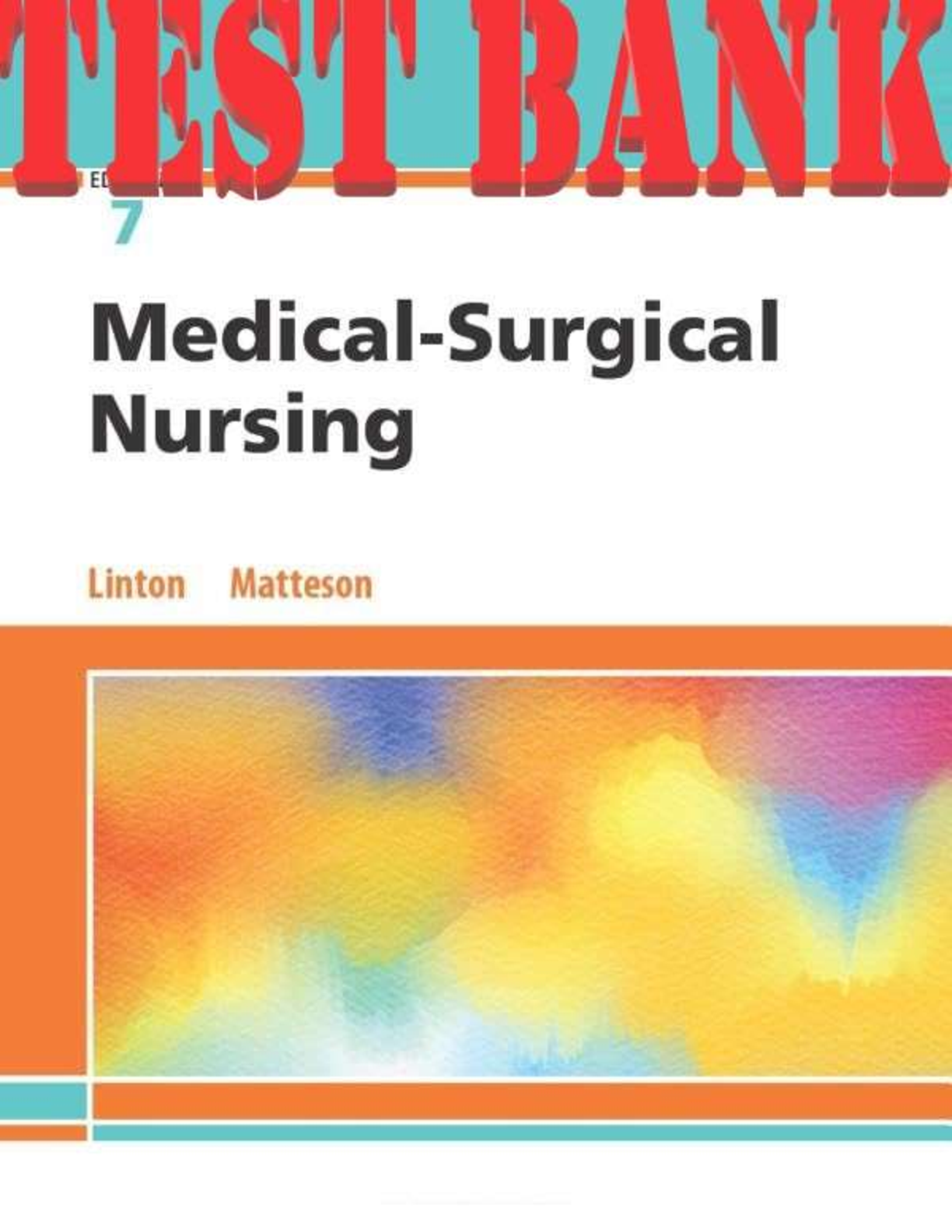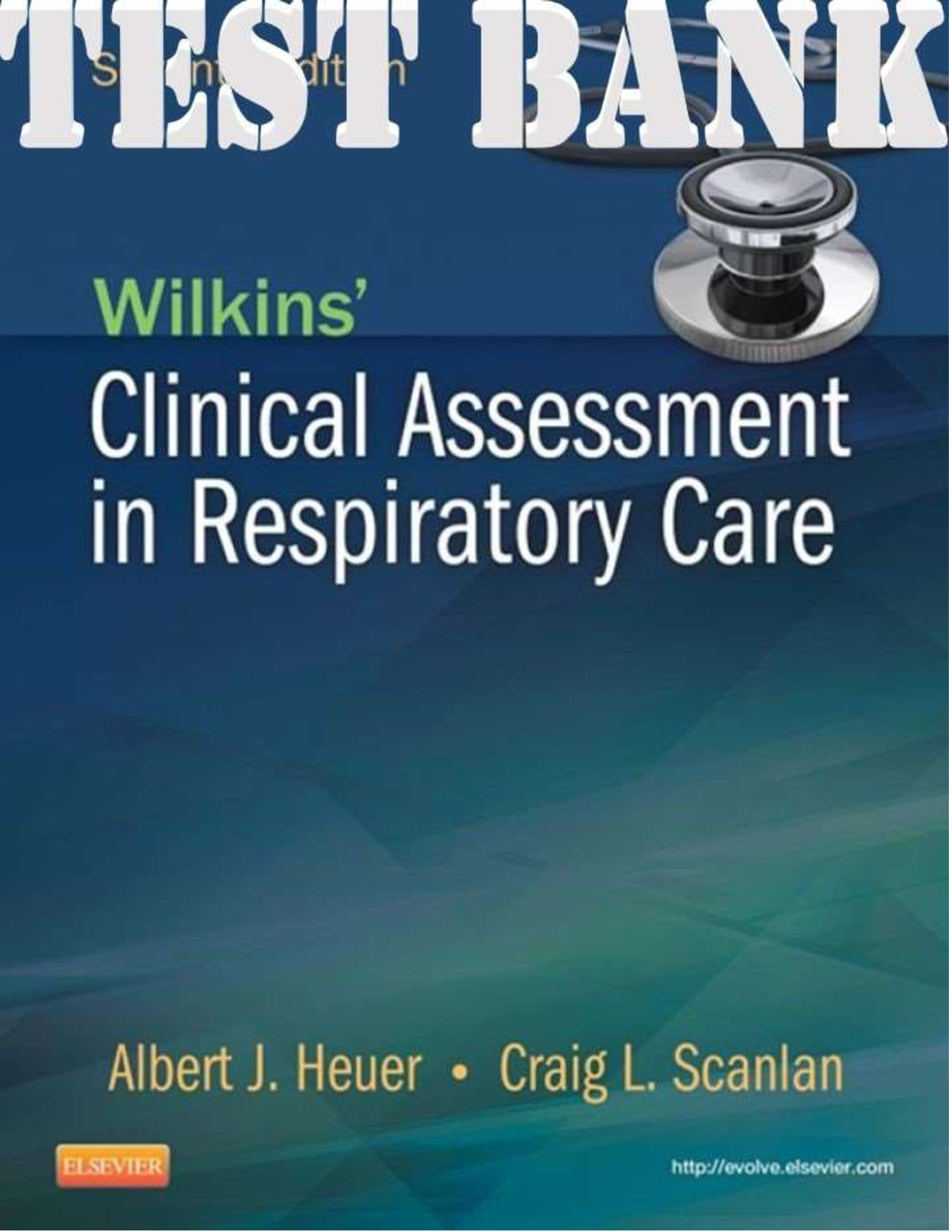*NURSING > TEST BANK > Physical Examination and Health Assessment, 7th Edition by Carolyn Jarvis -Test Bank / Jarvis: Physi (All)
Physical Examination and Health Assessment, 7th Edition by Carolyn Jarvis -Test Bank / Jarvis: Physical Examination & Health Assessment, 7th Edition (all chapters, deeply elaborated) Complete A+ Guide
Document Content and Description Below
Physical Examination and Health Assessment, 7th Edition by Carolyn Jarvis -Test Bank Chapter 03: The Interview Jarvis: Physical Examination & Health Assessment, 7th Edition MULTIPLE CHOICE... The nurse is conducting an interview with a woman who has recently learned that she is pregnant and who has come to the clinic today to begin prenatal care. The woman states that she and her husband are excited about the pregnancy but have a few questions. She looks nervously at her hands during the interview and sighs loudly. Considering the concept of communication, which statement does the nurse know to be most accurate? The woman is: a. Excited about her pregnancy but nervous about the labor. b. Exhibiting verbal and nonverbal behaviors that do not match. c. Excited about her pregnancy, but her husband is not and this is upsetting to her. d. Not excited about her pregnancy but believes the nurse will negatively respond to her if she states this. ANS: B Communication is all behaviors, conscious and unconscious, verbal and nonverbal. All behaviors have meaning. Her behavior does not imply that she is nervous about labor, upset by her husband, or worried about the nurse’s response. DIF: Cognitive Level: Analyzing (Analysis) REF: p. 28 MSC: Client Needs: Psychosocial Integrity Receiving is a part of the communication process. Which receiver is most likely to misinterpret a message sent by a health care professional? a. Well-adjusted adolescent who came in for a sports physical b. Recovering alcoholic who came in for a basic physical examination c. Man whose wife has just been diagnosed with lung cancer d. Man with a hearing impairment who uses sign language to communicate and who has an interpreter with him ANS: C The receiver attaches meaning determined by his or her experiences, culture, self-concept, and current physical and emotional states. The man whose wife has just been diagnosed with lung cancer may be experiencing emotions that affect his receiving. DIF: Cognitive Level: Analyzing (Analysis) REF: p. 28 MSC: Client Needs: Psychosocial Integrity The nurse makes which adjustment in the physical environment to promote the success of an interview? a. Reduces noise by turning off televisions and radios b. Reduces the distance between the interviewer and the patient to 2 feet or less c. Provides a dim light that makes the room cozy and helps the patient relax d. Arranges seating across a desk or table to allow the patient some personal space ANS: A The nurse should reduce noise by turning off the television, radio, and other unnecessary equipment, because multiple stimuli are confusing. The interviewer and patient should be approximately 4 to 5 feet apart; the room should be well-lit, enabling the interviewer and patient to see each other clearly. Having a table or desk in between the two people creates the idea of a barrier; equal-status seating, at eye level, is better. DIF: Cognitive Level: Applying (Application) REF: p. 29 MSC: Client Needs: Psychosocial Integrity In an interview, the nurse may find it necessary to take notes to aid his or her memory later. Which statement is true regarding note-taking? a. Note-taking may impede the nurse’s observation of the patient’s nonverbal behaviors. b. Note-taking allows the patient to continue at his or her own pace as the nurse records what is said. c. Note-taking allows the nurse to shift attention away from the patient, resulting in an increased comfort level. d. Note-taking allows the nurse to break eye contact with the patient, which may increase his or her level of comfort. ANS: A The use of history forms and note-taking may be unavoidable. However, the nurse must be aware that note-taking during the interview has disadvantages. It breaks eye contact too often and shifts the attention away from the patient, which diminishes his or her sense of importance. Note-taking may also interrupt the patient’s narrative flow, and it impedes the observation of the patient’s nonverbal behavior. DIF: Cognitive Level: Understanding (Comprehension) REF: p. 30 MSC: Client Needs: Psychosocial Integrity The nurse asks, “I would like to ask you some questions about your health and your usual daily activities so that we can better plan your stay here.” This question is found at the __________ phase of the interview process. a. Summary b. Closing c. Body d. Opening or introduction ANS: D When gathering a complete history, the nurse should give the reason for the interview during the opening or introduction phase of the interview, not during or at the end of the interview. DIF: Cognitive Level: Understanding (Comprehension) REF: p. 31 MSC: Client Needs: Psychosocial Integrity A woman has just entered the emergency department after being battered by her husband. The nurse needs to get some information from her to begin treatment. What is the best choice for an opening phase of the interview with this patient? a. “Hello, Nancy, my name is Mrs. C.” b. “Hello, Mrs. H., my name is Mrs. C. It sure is cold today!” c. “Mrs. H., my name is Mrs. C. How are you?” d. “Mrs. H., my name is Mrs. C. I’ll need to ask you a few questions about what happened.” ANS: D Address the person by using his or her surname. The nurse should introduce him or herself and give the reason for the interview. Friendly small talk is not needed to build rapport. DIF: Cognitive Level: Applying (Application) REF: p. 31 MSC: Client Needs: Psychosocial Integrity During an interview, the nurse states, “You mentioned having shortness of breath. Tell me more about that.” Which verbal skill is used with this statement? a. Reflection b. Facilitation c. Direct question d. Open-ended question ANS: D The open-ended question asks for narrative information. It states the topic to be discussed but only in general terms. The nurse should use it to begin the interview, to introduce a new section of questions, and whenever the person introduces a new topic. DIF: Cognitive Level: Understanding (Comprehension) REF: p. 31 MSC: Client Needs: Psychosocial Integrity A patient has finished giving the nurse information about the reason he is seeking care. When reviewing the data, the nurse finds that some information about past hospitalizations is missing. At this point, which statement by the nurse would be most appropriate to gather these data? a. “Mr. Y., at your age, surely you have been hospitalized before!” b. “Mr. Y., I just need permission to get your medical records from County Medical.” c. “Mr. Y., you mentioned that you have been hospitalized on several occasions. Would you tell me more about that?” d. “Mr. Y., I just need to get some additional information about your past hospitalizations. When was the last time you were admitted for chest pain?” ANS: D The nurse should use direct questions after the person’s opening narrative to fill in any details he or she left out. The nurse also should use direct questions when specific facts are needed, such as when asking about past health problems or during the review of systems. DIF: Cognitive Level: Applying (Application) REF: p. 31 MSC: Client Needs: Psychosocial Integrity In using verbal responses to assist the patient’s narrative, some responses focus on the patient’s frame of reference and some focus on the health care provider’s perspective. An example of a verbal response that focuses on the health care provider’s perspective would be: a. Empathy. b. Reflection. c. Facilitation. d. Confrontation. ANS: D When the health care provider uses the response of confrontation, the frame of reference shifts from the patient’s perspective to the perspective of the health care provider, and the health care provider starts to express his or her own thoughts and feelings. Empathy, reflection, and facilitation responses focus on the patient’s frame of reference. DIF: Cognitive Level: Remembering (Knowledge) REF: p. 32 MSC: Client Needs: Psychosocial Integrity When taking a history from a newly admitted patient, the nurse notices that he often pauses and expectantly looks at the nurse. What would be the nurse’s best response to this behavior? a. Be silent, and allow him to continue when he is ready. b. Smile at him and say, “Don’t worry about all of this. I’m sure we can find out why you’re having these pains.” c. Lean back in the chair and ask, “You are looking at me kind of funny; there isn’t anything wrong, is there?” d. Stand up and say, “I can see that this interview is uncomfortable for you. We can continue it another time.” ANS: A Silent attentiveness communicates that the person has time to think and to organize what he or she wishes to say without an interruption from the nurse. Health professionals most often interrupt this thinking silence. The other responses are not conducive to ideal communication. DIF: Cognitive Level: Applying (Application) REF: p. 33 MSC: Client Needs: Psychosocial Integrity A woman is discussing the problems she is having with her 2-year-old son. She says, “He won’t go to sleep at night, and during the day he has several fits. I get so upset when that happens.” The nurse’s best verbal response would be: a. “Go on, I’m listening.” b. “Fits? Tell me what you mean by this.” c. “Yes, it can be upsetting when a child has a fit.” d. “Don’t be upset when he has a fit; every 2 year old has fits.” ANS: B The nurse should use clarification when the person’s word choice is ambiguous or confusing (e.g., “Tell me what you mean by fits.”). Clarification is also used to summarize the person’s words or to simplify the words to make them clearer; the nurse should then ask if he or she is on the right track. DIF: Cognitive Level: Applying (Application) REF: p. 33 MSC: Client Needs: Psychosocial Integrity A 17-year-old single mother is describing how difficult it is to raise a 3-year-old child by herself. During the course of the interview she states, “I can’t believe my boyfriend left me to do this by myself! What a terrible thing to do to me!” Which of these responses by the nurse uses empathy? a. “You feel alone.” b. “You can’t believe he left you alone?” c. “It must be so hard to face this all alone.” d. “I would be angry, too; raising a child alone is no picnic.” ANS: C An empathetic response recognizes the feeling and puts it into words. It names the feeling, allows its expression, and strengthens rapport. Other empathetic responses are, “This must be very hard for you,” “I understand,” or simply placing your hand on the person’s arm. Simply reflecting the person’s words or agreeing with the person is not an empathetic response. DIF: Cognitive Level: Applying (Application) REF: p. 28 MSC: Client Needs: Psychosocial Integrity A man has been admitted to the observation unit for observation after being treated for a large cut on his forehead. As the nurse works through the interview, one of the standard questions has to do with alcohol, tobacco, and drug use. When the nurse asks him about tobacco use, he states, “I quit smoking after my wife died 7 years ago.” However, the nurse notices an open pack of cigarettes in his shirt pocket. Using confrontation, the nurse could say: a. “Mr. K., I know that you are lying.” b. “Mr. K., come on, tell me how much you smoke.” c. “Mr. K., I didn’t realize your wife had died. It must be difficult for you at this time. Please tell me more about that.” d. “Mr. K., you have said that you don’t smoke, but I see that you have an open pack of cigarettes in your pocket.” ANS: D In the case of confrontation, a certain action, feeling, or statement has been observed, and the nurse now focuses the patient’s attention on it. The nurse should give honest feedback about what is seen or felt. Confrontation may focus on a discrepancy, or the nurse may confront the patient when parts of the story are inconsistent. The other statements are not appropriate. DIF: Cognitive Level: Applying (Application) REF: p. 33 MSC: Client Needs: Psychosocial Integrity The nurse has used interpretation regarding a patient’s statement or actions. After using this technique, it would be best for the nurse to: a. Apologize, because using interpretation can be demeaning for the patient. b. Allow time for the patient to confirm or correct the inference. c. Continue with the interview as though nothing has happened. d. Immediately restate the nurse’s conclusion on the basis of the patient’s nonverbal response. ANS: B Interpretation is not based on direct observation as is confrontation, but it is based on one’s inference or conclusion. The nurse risks making the wrong inference. If this is the case, then the patient will correct it. However, even if the inference is correct, interpretation helps prompt further discussion of the topic. DIF: Cognitive Level: Analyzing (Analysis) REF: p. 33 MSC: Client Needs: Psychosocial Integrity During an interview, a woman says, “I have decided that I can no longer allow my children to live with their father’s violence, but I just can’t seem to leave him.” Using interpretation, the nurse’s best response would be: a. “You are going to leave him?” b. “If you are afraid for your children, then why can’t you leave?” c. “It sounds as if you might be afraid of how your husband will respond.” d. “It sounds as though you have made your decision. I think it is a good one.” ANS: C This statement is not based on one’s inference or conclusion. It links events, makes associations, or implies cause. Interpretation also ascribes feelings and helps the person understand his or her own feelings in relation to the verbal message. The other statements do not reflect interpretation. DIF: Cognitive Level: Applying (Application) REF: p. 33 MSC: Client Needs: Psychosocial Integrity A pregnant woman states, “I just know labor will be so painful that I won’t be able to stand it. I know it sounds awful, but I really dread going into labor.” The nurse responds by stating, “Oh, don’t worry about labor so much. I have been through it, and although it is painful, many good medications are available to decrease the pain.” Which statement is true regarding this response? The nurse’s reply was a: a. Therapeutic response. By sharing something personal, the nurse gives hope to this woman. b. Nontherapeutic response. By providing false reassurance, the nurse actually cut off further discussion of the woman’s fears. c. Therapeutic response. By providing information about the medications available, the nurse is giving information to the woman. d. Nontherapeutic response. The nurse is essentially giving the message to the woman that labor cannot be tolerated without medication. ANS: B By providing false assurance or reassurance, this courage builder relieves the woman’s anxiety and gives the nurse the false sense of having provided comfort. However, for the woman, providing false assurance or reassurance actually closes off communication, trivializes her anxiety, and effectively denies any further talk of it. DIF: Cognitive Level: Analyzing (Analysis) REF: p. 32 MSC: Client Needs: Psychosocial Integrity During a visit to the clinic, a patient states, “The doctor just told me he thought I ought to stop smoking. He doesn’t understand how hard I’ve tried. I just don’t know the best way to do it. What should I do?” The nurse’s most appropriate response in this case would be: a. “I’d quit if I were you. The doctor really knows what he is talking about.” b. “Would you like some information about the different ways a person can quit smoking?” c. “Stopping your dependence on cigarettes can be very difficult. I understand how you feel.” d. “Why are you confused? Didn’t the doctor give you the information about the smoking cessation program we offer?” ANS: B Clarification should be used when the person’s word choice is ambiguous or confusing. Clarification is also used to summarize the person’s words or to simplify the words to make them clearer; the nurse should then ask if he or she is on the right track. The other responses give unwanted advice or do not offer a helpful response. DIF: Cognitive Level: Applying (Application) REF: p. 33 MSC: Client Needs: Psychosocial Integrity As the nurse enters a patient’s room, the nurse finds her crying. The patient states that she has just found out that the lump in her breast is cancer and says, “I’m so afraid of, um, you know.” The nurse’s most therapeutic response would be to say in a gentle manner: a. “You’re afraid you might lose your breast?” b. “No, I’m not sure what you are talking about.” c. “I’ll wait here until you get yourself under control, and then we can talk.” d. “I can see that you are very upset. Perhaps we should discuss this later.” ANS: A Reflection echoes the patient’s words, repeating part of what the person has just said. Reflection can also help express the feelings behind a person’s words. DIF: Cognitive Level: Applying (Application) REF: p. 33 MSC: Client Needs: Psychosocial Integrity A nurse is taking complete health histories on all of the patients attending a wellness workshop. On the history form, one of the written questions asks, “You don’t smoke, drink, or take drugs, do you?” This question is an example of: a. Talking too much. b. Using confrontation. c. Using biased or leading questions. d. Using blunt language to deal with distasteful topics. ANS: C This question is an example of using leading or biased questions. Asking, “You don’t smoke, do you?” implies that one answer is better than another. If the person wants to please someone, then he or she is either forced to answer in a way that corresponds to his or her implied values or is made to feel guilty when admitting the other answer. DIF: Cognitive Level: Understanding (Comprehension) REF: p. 34 MSC: Client Needs: Psychosocial Integrity When observing a patient’s verbal and nonverbal communication, the nurse notices a discrepancy. Which statement is true regarding this situation? The nurse should: a. Ask someone who knows the patient well to help interpret this discrepancy. b. Focus on the patient’s verbal message, and try to ignore the nonverbal behaviors. c. Try to integrate the verbal and nonverbal messages and then interpret them as an average. d. Focus on the patient’s nonverbal behaviors, because these are often more reflective of a patient’s true feelings. ANS: D When nonverbal and verbal messages are congruent, the verbal message is reinforced. When they are incongruent, the nonverbal message tends to be the true one because it is under less conscious control. Thus studying the nonverbal messages of the patients and examiners and understanding their meanings are important. The other statements are not true. DIF: Cognitive Level: Applying (Application) REF: p. 28 MSC: Client Needs: Psychosocial Integrity During an interview, a parent of a hospitalized child is sitting in an open position. As the interviewer begins to discuss his son’s treatment, however, he suddenly crosses his arms against his chest and crosses his legs. This changed posture would suggest that the parent is: a. Simply changing positions. b. More comfortable in this position. c. Tired and needs a break from the interview. d. Uncomfortable talking about his son’s treatment. ANS: D The person’s position is noted. An open position with the extension of large muscle groups shows relaxation, physical comfort, and a willingness to share information. A closed position with the arms and legs crossed tends to look defensive and anxious. Any change in posture should be noted. If a person in a relaxed position suddenly tenses, then this change in posture suggests possible discomfort with the new topic. DIF: Cognitive Level: Analyzing (Analysis) REF: p. 35 MSC: Client Needs: Psychosocial Integrity A mother brings her 28-month-old daughter into the clinic for a well-child visit. At the beginning of the visit, the nurse focuses attention away from the toddler, but as the interview progresses, the toddler begins to “warm up” and is smiling shyly at the nurse. The nurse will be most successful in interacting with the toddler if which is done next? a. Tickle the toddler, and get her to laugh. b. Stoop down to her level, and ask her about the toy she is holding. c. Continue to ignore her until it is time for the physical examination. d. Ask the mother to leave during the examination of the toddler, because toddlers often fuss less if their parent is not in view. ANS: B Although most of the communication is with the parent, the nurse should not completely ignore the child. Making contact will help ease the toddler later during the physical examination. The nurse should begin by asking about the toys the child is playing with or about a special doll or teddy bear brought from home. “Does your doll have a name?” or “What can your truck do?” Stoop down to meet the child at his or her eye level. DIF: Cognitive Level: Applying (Application) REF: p. 37 MSC: Client Needs: Psychosocial Integrity During an examination of a 3-year-old child, the nurse will need to take her blood pressure. What might the nurse do to try to gain the child’s full cooperation? a. Tell the child that the blood pressure cuff is going to give her arm a big hug. b. Tell the child that the blood pressure cuff is asleep and cannot wake up. c. Give the blood pressure cuff a name and refer to it by this name during the assessment. d. Tell the child that by using the blood pressure cuff, we can see how strong her muscles are. ANS: D Take the time to give a short, simple explanation with a concrete explanation for any unfamiliar equipment that will be used on the child. Preschoolers are animistic; they imagine inanimate objects can come alive and have human characteristics. Thus a blood pressure cuff can wake up and bite or pinch. DIF: Cognitive Level: Applying (Application) REF: pp. 38-39 MSC: Client Needs: Psychosocial Integrity A 16-year-old boy has just been admitted to the unit for overnight observation after being in an automobile accident. What is the nurse’s best approach to communicating with him? a. Use periods of silence to communicate respect for him. b. Be totally honest with him, even if the information is unpleasant. c. Tell him that everything that is discussed will be kept totally confidential. d. Use slang language when possible to help him open up. ANS: B Successful communication with an adolescent is possible and can be rewarding. The guidelines are simple. The first consideration is one’s attitude, which must be one of respect. Second, communication must be totally honest. An adolescent’s intuition is highly tuned and can detect phoniness or the withholding of information. Always tell him or her the truth. DIF: Cognitive Level: Applying (Application) REF: p. 39 MSC: Client Needs: Psychosocial Integrity A 75-year-old woman is at the office for a preoperative interview. The nurse is aware that the interview may take longer than interviews with younger persons. What is the reason for this? a. An aged person has a longer story to tell. b. An aged person is usually lonely and likes to have someone with whom to talk. c. Aged persons lose much of their mental abilities and require longer time to complete an interview. d. As a person ages, he or she is unable to hear; thus the interviewer usually needs to repeat much of what is said. ANS: A The interview usually takes longer with older adults because they have a longer story to tell. It is not necessarily true that all older adults are lonely, have lost mental abilities, or are hard of hearing. DIF: Cognitive Level: Understanding (Comprehension) REF: p. 40 MSC: Client Needs: Psychosocial Integrity The nurse is interviewing a male patient who has a hearing impairment. What techniques would be most beneficial in communicating with this patient? a. Determine the communication method he prefers. b. Avoid using facial and hand gestures because most hearing-impaired people find this degrading. c. Request a sign language interpreter before meeting with him to help facilitate the communication. d. Speak loudly and with exaggerated facial movement when talking with him because doing so will help him lip read. ANS: A The nurse should ask the deaf person the preferred way to communicate—by signing, lip reading, or writing. If the person prefers lip reading, then the nurse should be sure to face him squarely and have good lighting on the nurse’s face. The nurse should not exaggerate lip movements because this distorts words. Similarly, shouting distorts the reception of a hearing aid the person may wear. The nurse should speak slowly and supplement his or her voice with appropriate hand gestures or pantomime. DIF: Cognitive Level: Understanding (Comprehension) REF: p. 41 MSC: Client Needs: Psychosocial Integrity During a prenatal check, a patient begins to cry as the nurse asks her about previous pregnancies. She states that she is remembering her last pregnancy, which ended in miscarriage. The nurse’s best response to her crying would be: a. “I’m so sorry for making you cry!” b. “I can see that you are sad remembering this. It is all right to cry.” c. “Why don’t I step out for a few minutes until you’re feeling better?” d. “I can see that you feel sad about this; why don’t we talk about something else?” ANS: B A beginning examiner usually feels horrified when the patient starts crying. When the nurse says something that “makes the person cry,” the nurse should not think he or she has hurt the person. The nurse has simply hit on an important topic; therefore, moving on to a new topic is essential. The nurse should allow the person to cry and to express his or her feelings fully. The nurse can offer a tissue and wait until the crying subsides to talk. DIF: Cognitive Level: Applying (Application) REF: p. 42 MSC: Client Needs: Psychosocial Integrity A female nurse is interviewing a man who has recently immigrated. During the course of the interview, he leans forward and then finally moves his chair close enough that his knees are nearly touching the nurse’s knees. The nurse begins to feel uncomfortable with his proximity. Which statement most closely reflects what the nurse should do next? a. The nurse should try to relax; these behaviors are culturally appropriate for this person. b. The nurse should discreetly move his or her chair back until the distance is more comfortable, and then continue with the interview. c. These behaviors are indicative of sexual aggression, and the nurse should confront this person about his behaviors. d. The nurse should laugh but tell him that he or she is uncomfortable with his proximity and ask him to move away. ANS: A Both the patient’s and the nurse’s sense of spatial distance are significant throughout the interview and physical examination, with culturally appropriate distance zones varying widely. Some cultural groups value close physical proximity and may perceive a health care provider who is distancing him or herself as being aloof and unfriendly. DIF: Cognitive Level: Analyzing (Analysis) REF: p. 29 MSC: Client Needs: Psychosocial Integrity A female American Indian has come to the clinic for follow-up diabetic teaching. During the interview, the nurse notices that she never makes eye contact and speaks mostly to the floor. Which statement is true regarding this situation? a. The woman is nervous and embarrassed. b. She has something to hide and is ashamed. c. The woman is showing inconsistent verbal and nonverbal behaviors. d. She is showing that she is carefully listening to what the nurse is saying. ANS: D Eye contact is perhaps among the most culturally variable nonverbal behaviors. Asian, American Indian, Indochinese, Arabian, and Appalachian people may consider direct eye contact impolite or aggressive, and they may avert their eyes during the interview. American Indians often stare at the floor during the interview, which is a culturally appropriate behavior, indicating that the listener is paying close attention to the speaker. DIF: Cognitive Level: Analyzing (Analysis) REF: p. 36 MSC: Client Needs: Psychosocial Integrity The nurse is performing a health interview on a patient who has a language barrier, and no interpreter is available. Which is the best example of an appropriate question for the nurse to ask in this situation? a. “Do you take medicine?” b. “Do you sterilize the bottles?” c. “Do you have nausea and vomiting?” d. “You have been taking your medicine, haven’t you?” ANS: A In a situation during which a language barrier exists and no interpreter is available, simple words should be used, avoiding medical jargon. The use of contractions and pronouns should also be avoided. Nouns should be repeatedly used, and one topic at a time should be discussed. DIF: Cognitive Level: Analyzing (Analysis) REF: p. 46 MSC: Client Needs: Psychosocial Integrity A man arrives at the clinic for his annual wellness physical. He is experiencing no acute health problems. Which question or statement by the nurse is most appropriate when beginning the interview? a. “How is your family?” b. “How is your job?” c. “Tell me about your hypertension.” d. “How has your health been since your last visit?” ANS: D Open-ended questions are used for gathering narrative information. This type of questioning should be used to begin the interview, to introduce a new section of questions, and whenever the person introduces a new topic. DIF: Cognitive Level: Applying (Application) REF: p. 31 MSC: Client Needs: Psychosocial Integrity The nurse makes this comment to a patient, “I know it may be hard, but you should do what the doctor ordered because she is the expert in this field.” Which statement is correct about the nurse’s comment? a. This comment is inappropriate because it shows the nurse’s bias. b. This comment is appropriate because members of the health care team are experts in their area of patient care. c. This type of comment promotes dependency and inferiority on the part of the patient and is best avoided in an interview situation. d. Using authority statements when dealing with patients, especially when they are undecided about an issue, is necessary at times. ANS: C Using authority responses promotes dependency and inferiority. Avoiding the use of authority is best. Although the health care provider and patient do not have equal professional knowledge, both have equally worthy roles in the health process. The other statements are not correct. DIF: Cognitive Level: Applying (Application) REF: p. 34 MSC: Client Needs: Psychosocial Integrity A female patient does not speak English well, and the nurse needs to choose an interpreter. Which of the following would be the most appropriate choice? a. Trained interpreter b. Male family member c. Female family member d. Volunteer college student from the foreign language studies department ANS: A Whenever possible, the nurse should use a trained interpreter, preferably one who knows medical terminology. In general, an older, more mature interpreter is preferred to a younger, less experienced one, and the same gender is preferred when possible. DIF: Cognitive Level: Understanding (Comprehension) REF: p. 44 MSC: Client Needs: Psychosocial Integrity During a follow-up visit, the nurse discovers that a patient has not been taking his insulin on a regular basis. The nurse asks, “Why haven’t you taken your insulin?” Which statement is an appropriate evaluation of this question? a. This question may place the patient on the defensive. b. This question is an innocent search for information. c. Discussing his behavior with his wife would have been better. d. A direct question is the best way to discover the reasons for his behavior. ANS: A The adult’s use of “why” questions usually implies blame and condemnation and places the person on the defensive. The other statements are not correct. DIF: Cognitive Level: Analyzing (Analysis) REF: p. 34 MSC: Client Needs: Psychosocial Integrity The nurse is nearing the end of an interview. Which statement is appropriate at this time? a. “Did we forget something?” b. “Is there anything else you would like to mention?” c. “I need to go on to the next patient. I’ll be back.” d. “While I’m here, let’s talk about your upcoming surgery.” ANS: B This question offers the person a final opportunity for self-expression. No new topic should be introduced. The other questions are not appropriate. DIF: Cognitive Level: Understanding (Comprehension) REF: p. 36 MSC: Client Needs: Psychosocial Integrity During the interview portion of data collection, the nurse collects __________ data. a. Physical b. Historical c. Objective d. Subjective ANS: D The interview is the first, and really the most important, part of data collection. During the interview, the nurse collects subjective data; that is, what the person says about him or herself. DIF: Cognitive Level: Remembering (Knowledge) REF: p. 27 MSC: Client Needs: Psychosocial Integrity During an interview, the nurse would expect that most of the interview will take place at what distance? a. Intimate zone b. Personal distance c. Social distance d. Public distance ANS: C Social distance, 4 to 12 feet, is usually the distance category for most of the interview. Public distance, over 12 feet, is too much distance; the intimate zone is inappropriate, and the personal distance will be used for the physical assessment. DIF: Cognitive Level: Understanding (Comprehension) REF: p. 29 MSC: Client Needs: Psychosocial Integrity A female nurse is interviewing a male patient who is near the same age as the nurse. During the interview, the patient makes an overtly sexual comment. The nurse’s best reaction would be: a. “Stop that immediately!” b. “Oh, you are too funny. Let’s keep going with the interview.” c. “Do you really think I would be interested?” d. “It makes me uncomfortable when you talk that way. Please stop.” ANS: D The nurse’s response must make it clear that she is a health professional who can best care for the person by maintaining a professional relationship. At the same time, the nurse should communicate that he or she accepts the person and understands the person’s need to be self-assertive but that sexual advances cannot be tolerated. DIF: Cognitive Level: Analyzing (Analysis) REF: p. 42 MSC: Client Needs: Psychosocial Integrity MULTIPLE RESPONSE The nurse is conducting an interview. Which of these statements is true regarding open-ended questions? Select all that apply. a. Open-ended questions elicit cold facts. b. They allow for self-expression. c. Open-ended questions build and enhance rapport. d. They leave interactions neutral. e. Open-ended questions call for short one- to two-word answers. f. They are used when narrative information is needed. ANS: B, C, F Open-ended questions allow for self-expression, build and enhance rapport, and obtain narrative information. These features enhance communication during an interview. The other statements are appropriate for closed or direct questions. DIF: Cognitive Level: Applying (Application) REF: p. 31 MSC: Client Needs: Psychosocial Integrity The nurse is conducting an interview in an outpatient clinic and is using a computer to record data. Which are the best uses of the computer in this situation? Select all that apply. a. Collect the patient’s data in a direct, face-to-face manner. b. Enter all the data as the patient states them. c. Ask the patient to wait as the nurse enters the data. d. Type the data into the computer after the narrative is fully explored. e. Allow the patient to see the monitor during typing. ANS: A, D, E The use of a computer can become a barrier. The nurse should begin the interview as usual by greeting the patient, establishing rapport, and collecting the patient’s narrative story in a direct, face-to-face manner. Only after the narrative is fully explored should the nurse type data into the computer. When typing, the nurse should position the monitor so that the patient can see it. DIF: Cognitive Level: Applying (Application) REF: pp. 30-31 MSC: Client Needs: Psychosocial Integrity [Show More]
Last updated: 1 year ago
Preview 1 out of 256 pages
Instant download

Buy this document to get the full access instantly
Instant Download Access after purchase
Add to cartInstant download
Reviews( 0 )
Document information
Connected school, study & course
About the document
Uploaded On
Feb 13, 2021
Number of pages
256
Written in
Additional information
This document has been written for:
Uploaded
Feb 13, 2021
Downloads
0
Views
62


